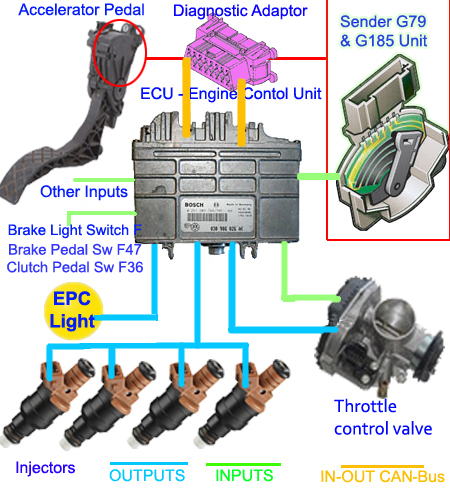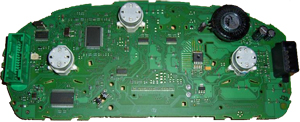Continued from EPC DEMYSTIFIED.
....But it’s not that simple. There is a lot more to it than meets the eye.....
PART 2
But it’s not that simple. There is a lot more to it than meets the eye. Cars exclusively use embedded microcontrollers (µContollers) with embedded firmware in preference to microprocessors with loadable software. In order for a microprocessor to function properly in any device, it must contain dedicated internal circuitry and firmware specific to its function, have inputs and outputs and an oscillator circuit among other circuitry and an OS (Operating system). A DVR (Digital Video recorder), or a PVR (personal Video recorder) or a set-top-box or embedded network appliance or data router are just a few examples of such systems. µControllers are less significant and less sophisticated than microprocessors, more dedicated to its specific need, often cheaper, faster, safer and smaller. Embedded µControllers are therefore the natural choice for car manufacturers. And there are several manufactures that produce µControllers families specifically for the motor trade.
So it should be understood that companies like Bosch, Digifant, Delco and other engine management ECU manufacturers and electronic module manufacturers uses the same microcontroller chip families or similar microcontroller chip families, designed and manufactured for them by a selected few silicon chip manufacturers. In the same vein, computer manufacturers like IBM, Dell, Sony, Toshiba and Lenovo, etc. all use microprocessors manufactured by Intel Corporation or AMD in their laptops and computers, whereas Apple uses microprocessors manufactured by Motorola.
Baring in mind, that much like Motorola, Intel Corporation and AMD produces different featured microprocessor chips with different instruction sets, along with their auxiliary support chips for low-end and high-end computers; such as 4 bit, 8bit, 16bit, 8086 family of chips, 32bit Pentiums, I5, I7, 64bit, XEON, 128bit big Endian and small Endian microprocessors etc; so does Infineon, Altera, Freescale, Atmel and ARM etc, manufacture different featured microcontroller chips for both low-end cars and high-end cars which are specifically chosen for their internal features and software by the various ECU and electronic module manufacturers like Bosch, LUCAS, DENSO, Delco, DELPHI, FENIX, HITACHI, HELLA, MARELLI, Siemens, etc. These microcontroller chip families can roughly be categorized into four sub sectors, those specific to Powertrain functions (P), those specific to the Body and Safety functions (B), those with specific functions for Chassis (C) and those specific to Internal Convenience & communication(U).
In a nutshell all the sub systems in your vehicle are controlled by these on-board computer chips, each at the heart of an electronic module flanked by associated components and sensors. Each of these modules are in fact a fully fledged computer in its own right, situated in various positions throughout the car and linked together by a wired networked called a network bus and all are accessible through the Databus diagnostic interface for adaptation.
When the ignition is switched on, several dashboard warning lamps light-up and stays lit for the duration of the internal test cycle (<30 seconds). Should all tests check OK, all lights goes however if all systems does not check out OK, the relevant light will stay on and a fault will be logged in memory . After the car is started, the ECU monitors all sensors and continually takes readings from the complete range of powertrain modules and sensors. These readings are then compared with default readings stored in the operational logic of the system. Should the sensor reading coincide and agree with the stored program value or values, the microcontroller will send the required outputs to the relevant actuators, for example the injectors. If the sensor readings differ and are out of specification, "not within the required limits", it will take another and if this sensor reading continues to be ‘out of limits’ a DTC will be triggered and sent to non-volatile memory. Depending on the nature of the fault, the embedded program may or may not instruct the microcontroller to make internal changes, thus operate on different criteria until a repair is effected, or until the fault has been cleared.
So whenever a mechanical or electronic problem arises in either the Powertrain (P), the Body (B), the Chassis (C) or the internal Conveniences & Communication (U) areas, the relevant module or modules triggers the on-board self diagnostics program and generates a DTC (Diagnostic Trouble Code) which is then stored in the non-volatile memory of the ECU for later retrieval by mechanical technicians. At the point When a DTC code is logged in memory, the system self-diagnosis system also alerts the driver with a visible indication of trouble by turning on a warning light on the dashboard like the "EPC light", or the "Malfunction Indicator Lamp" (MIL) which on European cars is known as the "Check Engine Light". This doesn't tell you the nature of the problem, even though it could be something serious, or not. After the necessary repairs are completed, a diagnostic scan tool should be used to clear the DTC errors and to turn the malfunction indicator light (MIL) or EPC light off. Thereafter the car should be taken on a short test dive to ascertain that the previous drive issue or issues are resolved. Then the car should be hooked up to the diagnostic scan tool once again in order to confirms that the DTC or DTCs is also no longer present.
The nature of such mechanical problem may prevent the engine from starting or it may idle erratically, switch off immediately after starting, refuse to rev higher than 1500 rpm and impede driveability (limp mode), difficult cold starting, misfire, lazy acceleration, high idling speed, fluctuating rev counter, excessive fuel consumption, difficult warm starting, excessive black smoke, poor engine response or emits blue/grey smoke, etc ... Each of these faults and so many others each produce individualized codes. In most cases it would be expedient to engage the services of a roll-back to get your car to a VW service center so that diagnostics can be run on the car.
With sufficient knowledge and an appropriate diagnostic apparatus (Autoboss, Pico Scope, Range, VCDS, AutoEnginuity, ScanXLpro), code reader or scanner, plugged into the car's 16 pin diagnostic plug, mechanical minded persons can read these faults, print then or save them to an SD card or harddrive, send signals and communicate with the ECUs, read the measured values and interrogate the actuators. The DTC in memory however do not identify the part that has gone faulty but rather provides you with a general idea to its area of origin. Often long before a DTC code is generated the fault may already have existed so when the you view the DTC it could show that the fault occurred twice of thrice or even six times before. The ECU software is designed to monitor the frequency of error and if it is an isolated occurrence the ECU clears the fault after a certain distance is traveled but that dependent on the severity of the fault. For arguement's sake lets say 300kms. If it happens once in 300kms it could automatically clears the fault but should it happen four times during the same distance a DTC will be registered, the car could go into limp mode since it may be unsafe to drive the car if it's a breaking or steering issue, or shut the engine off if the O2 sensor went faulty and can't regulate the smoke pollution, or disable starting if the knock sensor triggered the DTC as there may be no oil in sump which could amount to a very expensive engine repair. In the case of the latter, the oil light should have illuminated long before the knock sensor shuts the engine off. However I have encountered a problem with the wires that plug into the oil sensor that became brittle due to engine heat and subsequently broke off. As a result the sender sent the low oil condition but it never arrived at the the ECU hence did not turn-on the oil-low light. I only became aware of this when my EPC light went on due to the knock sensor. See picture in blog. More ...




+SCHEMATIC.jpg)



